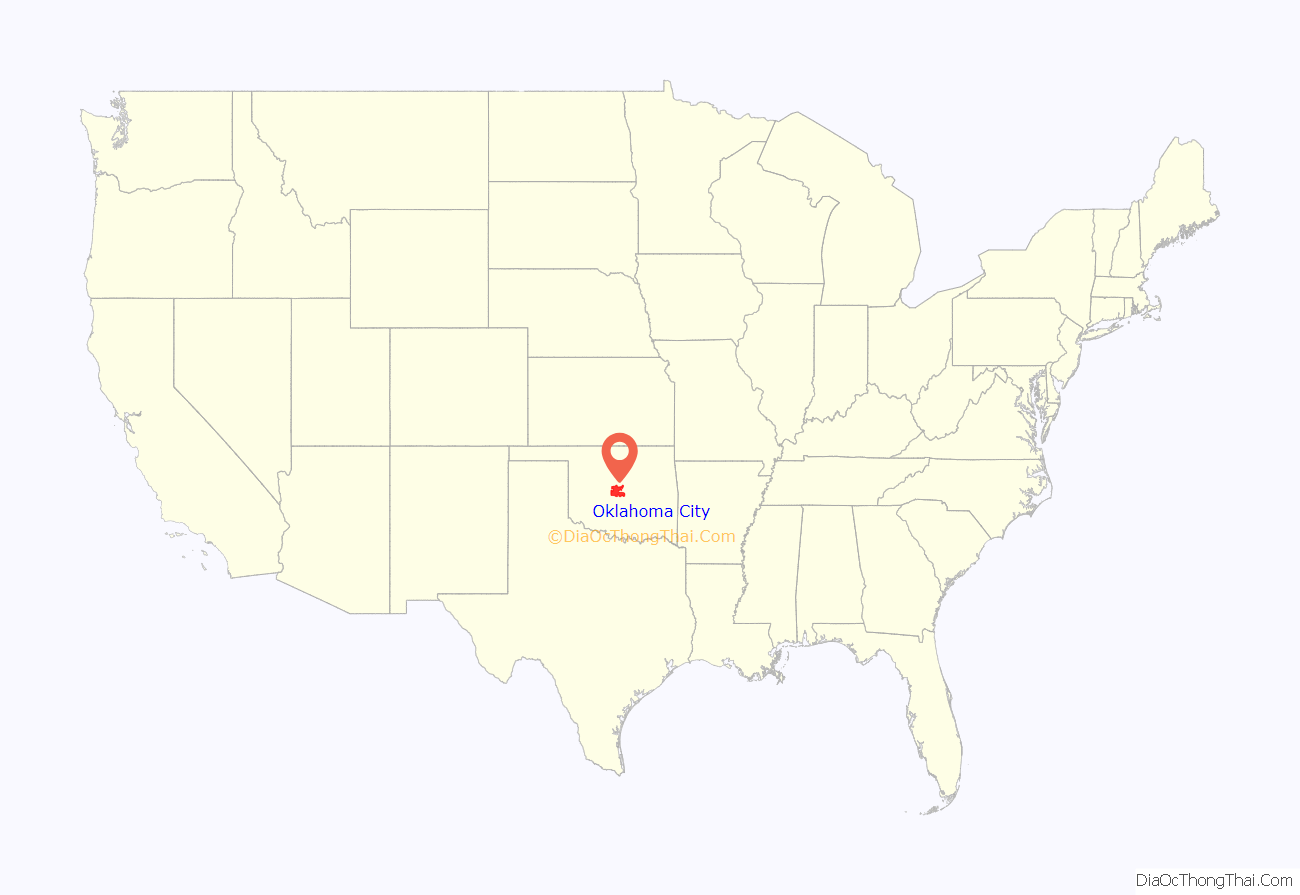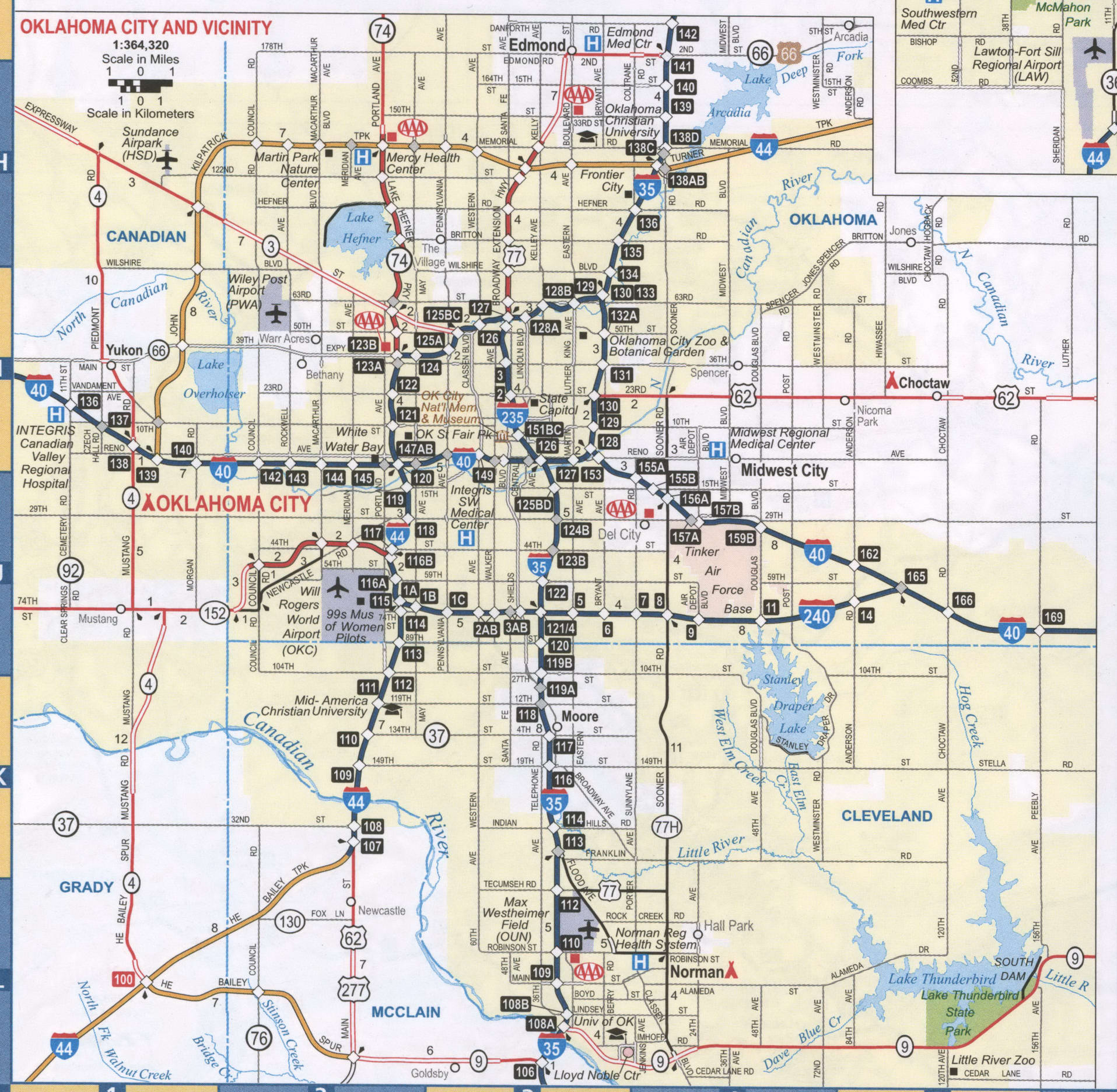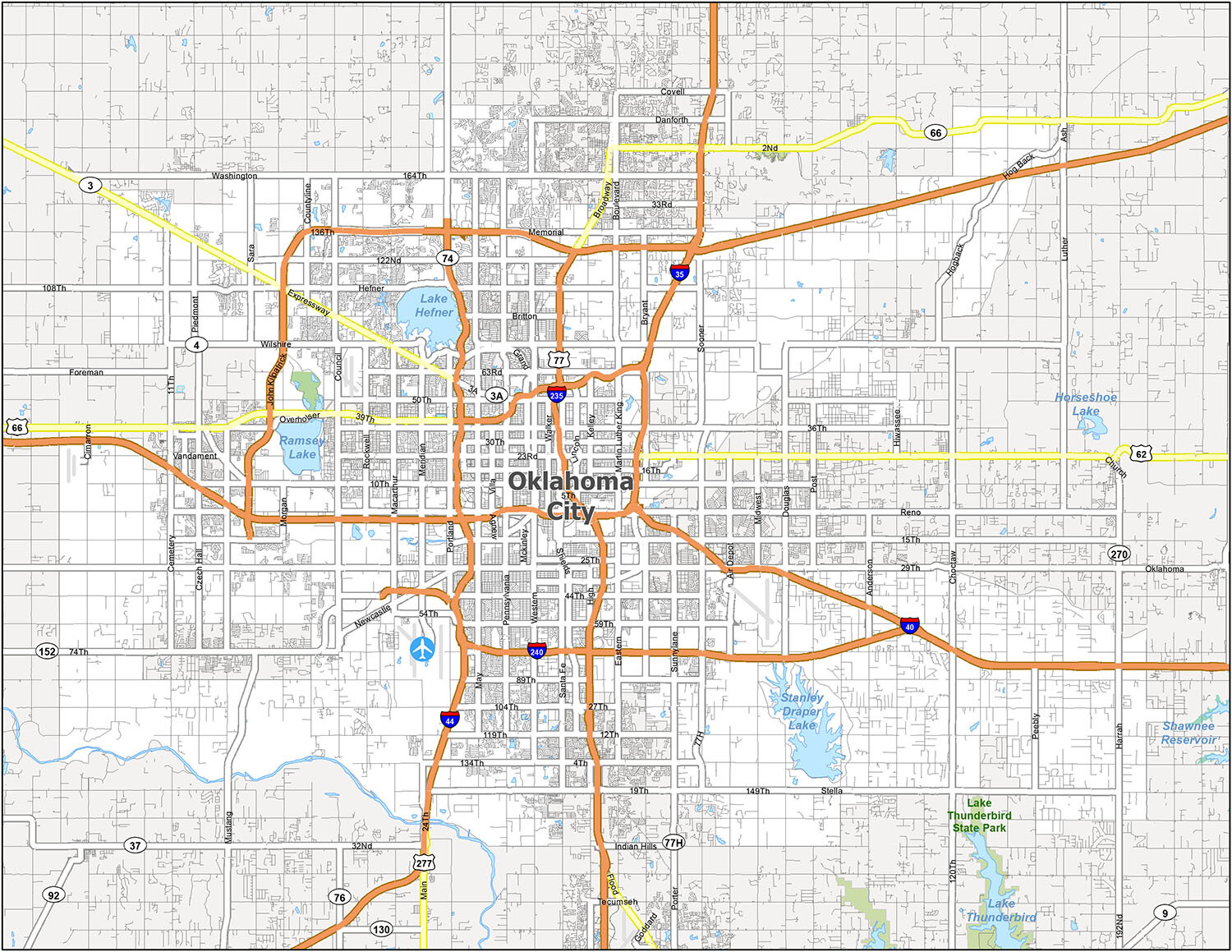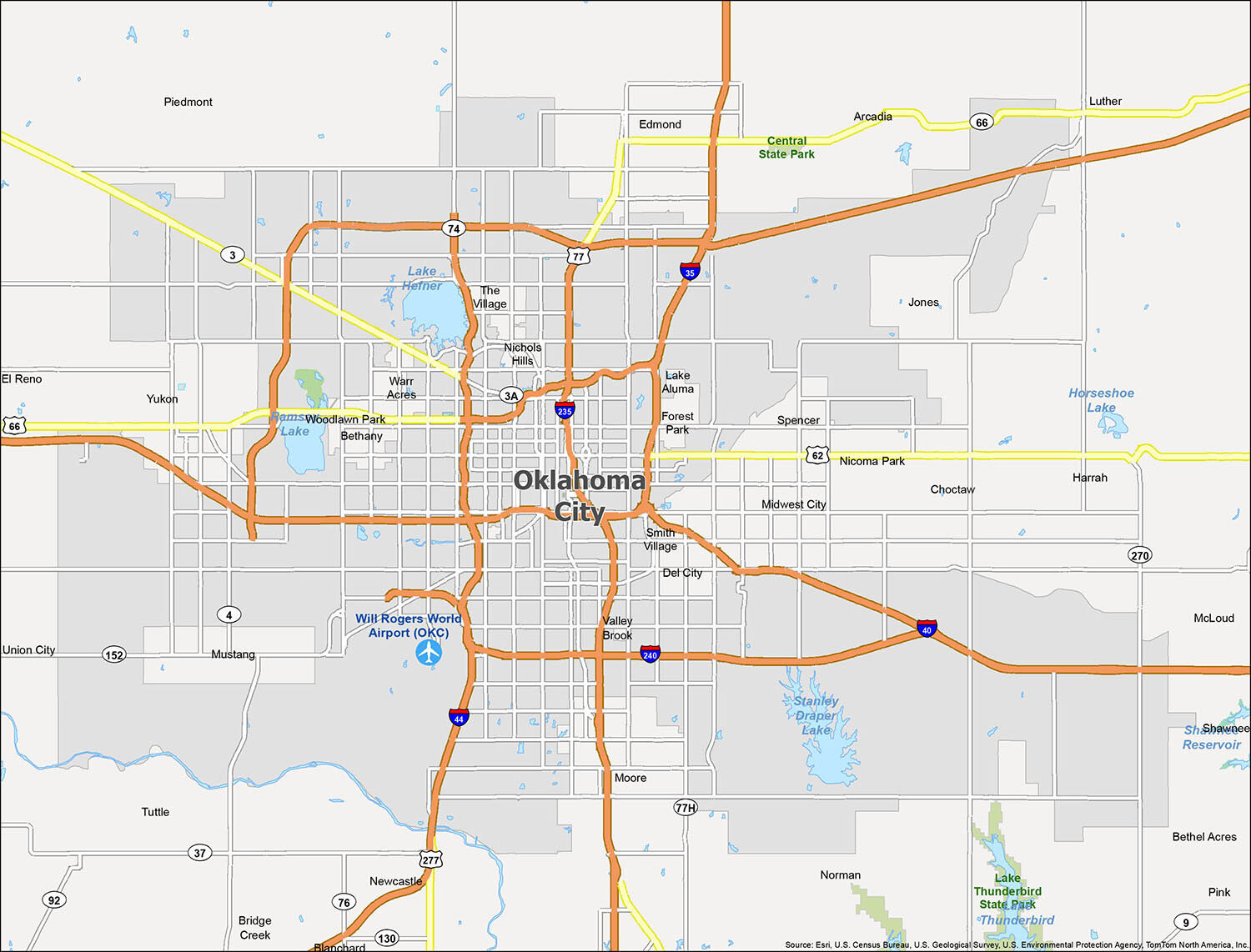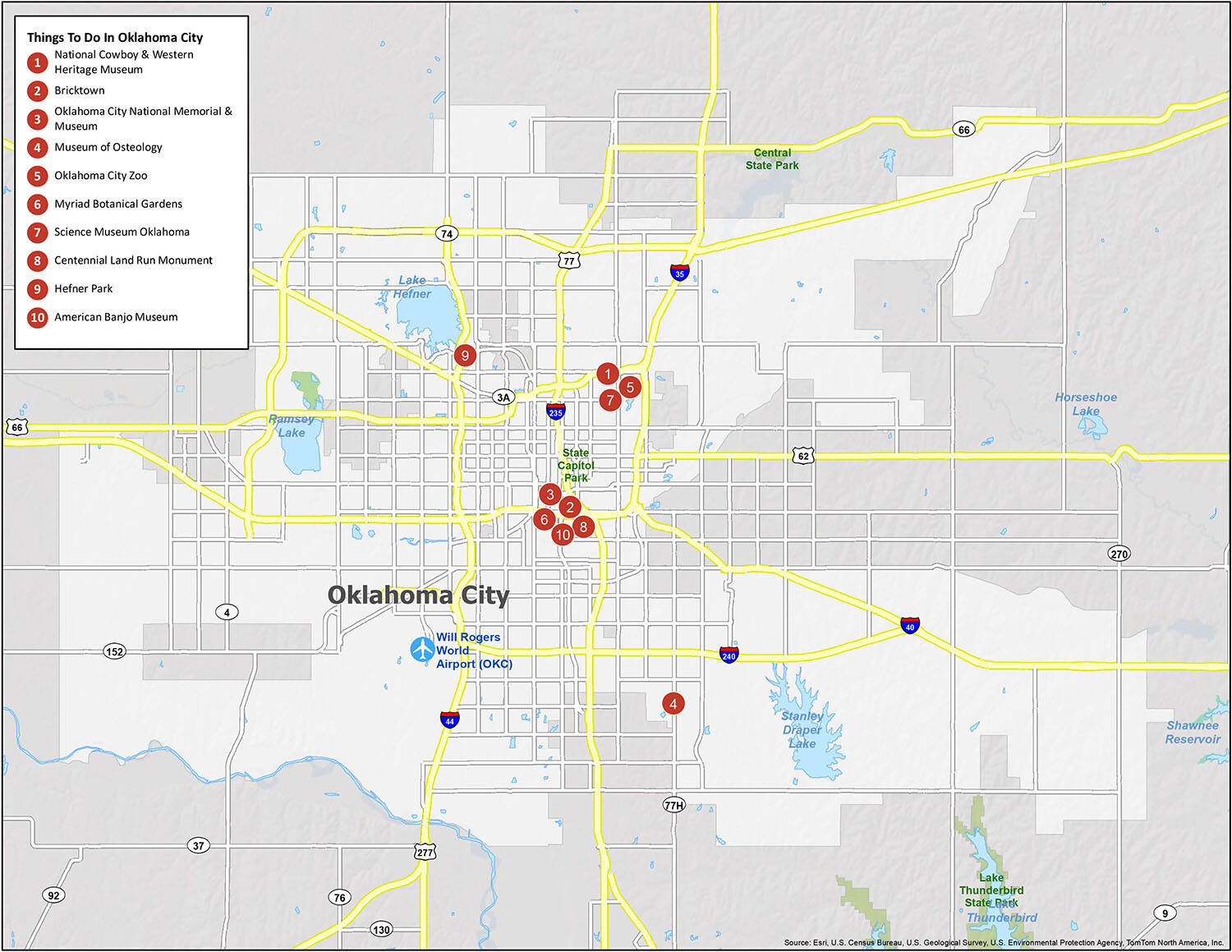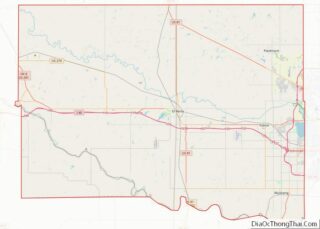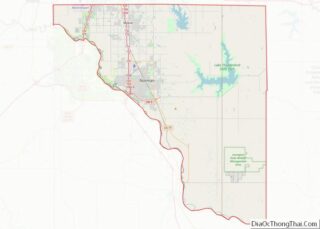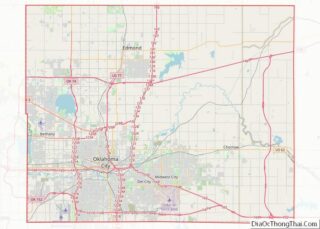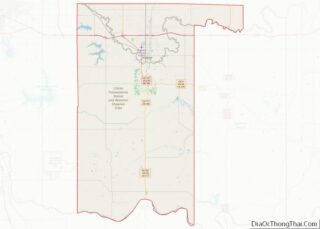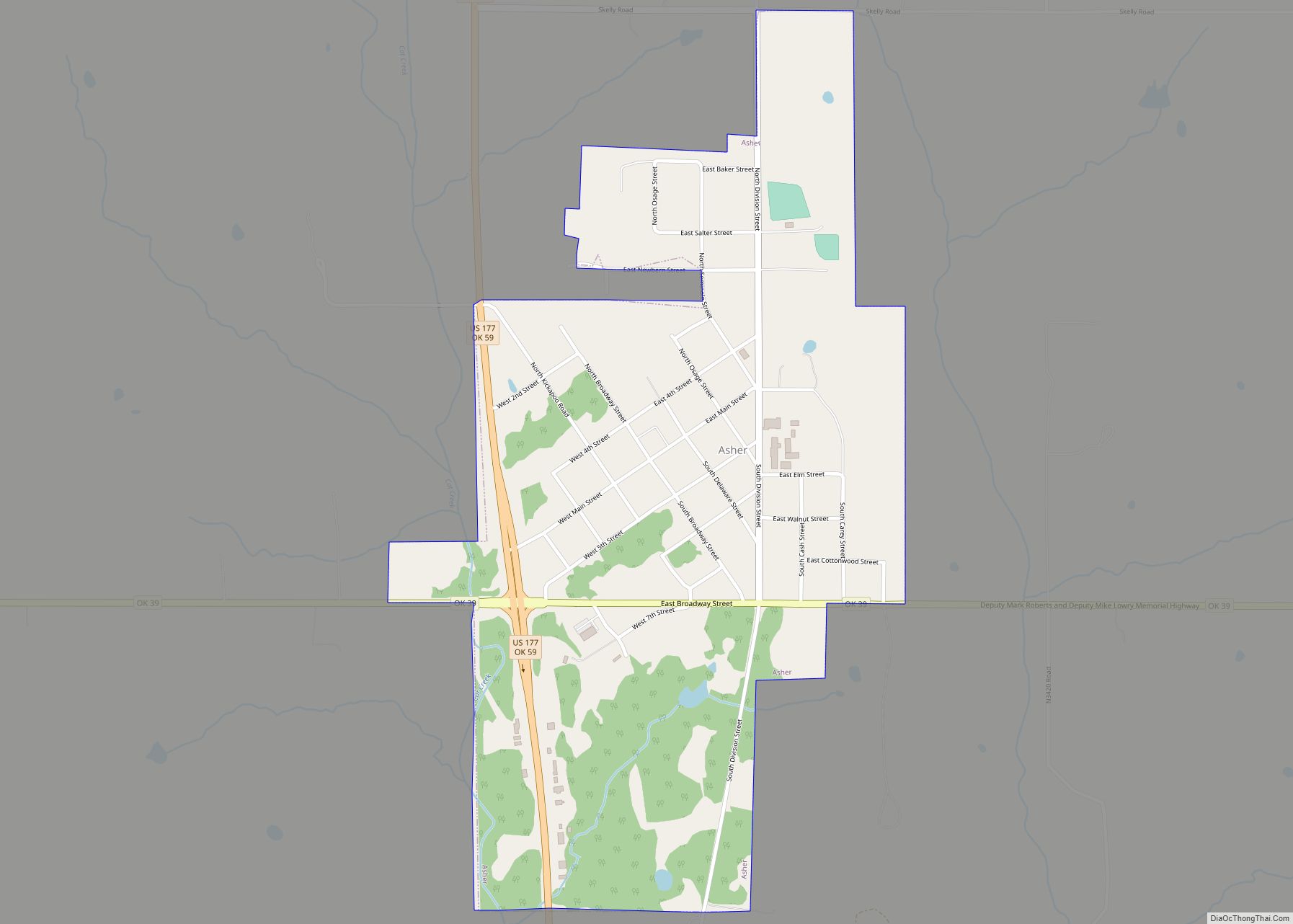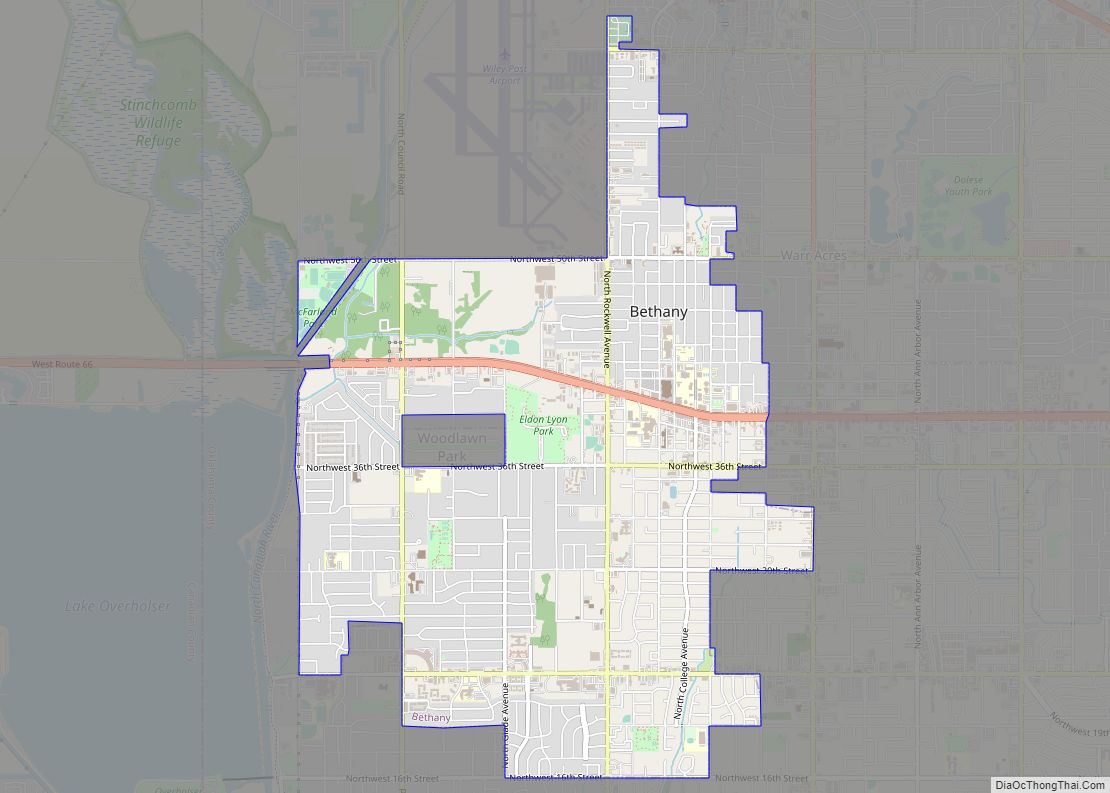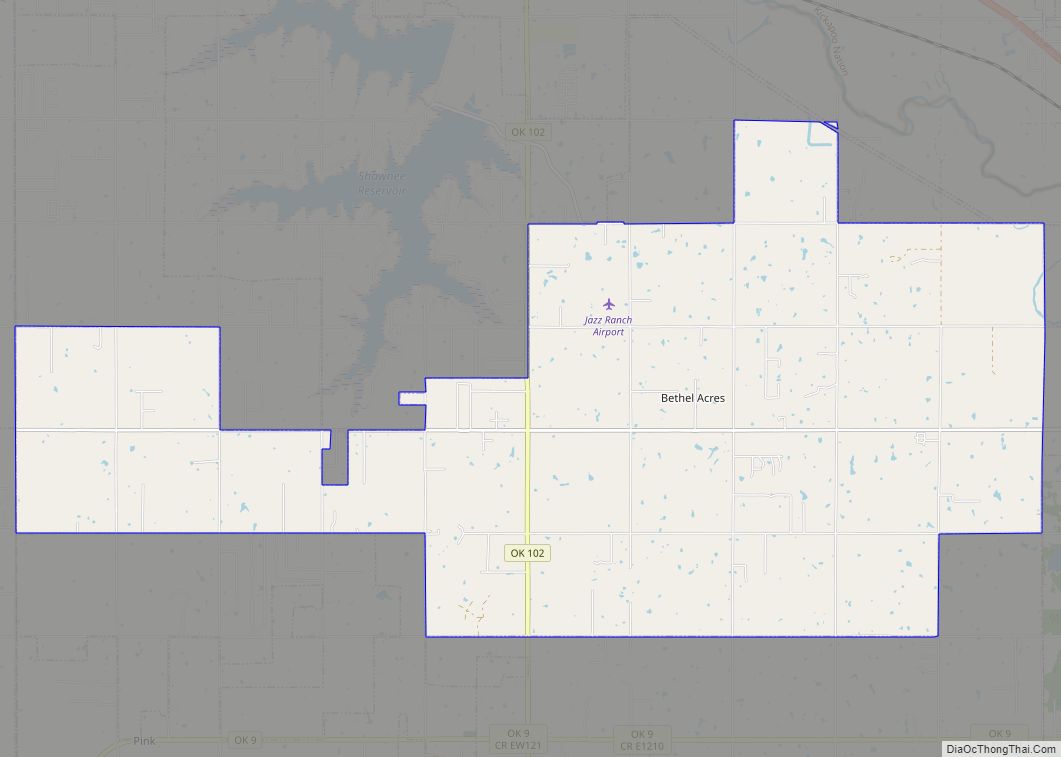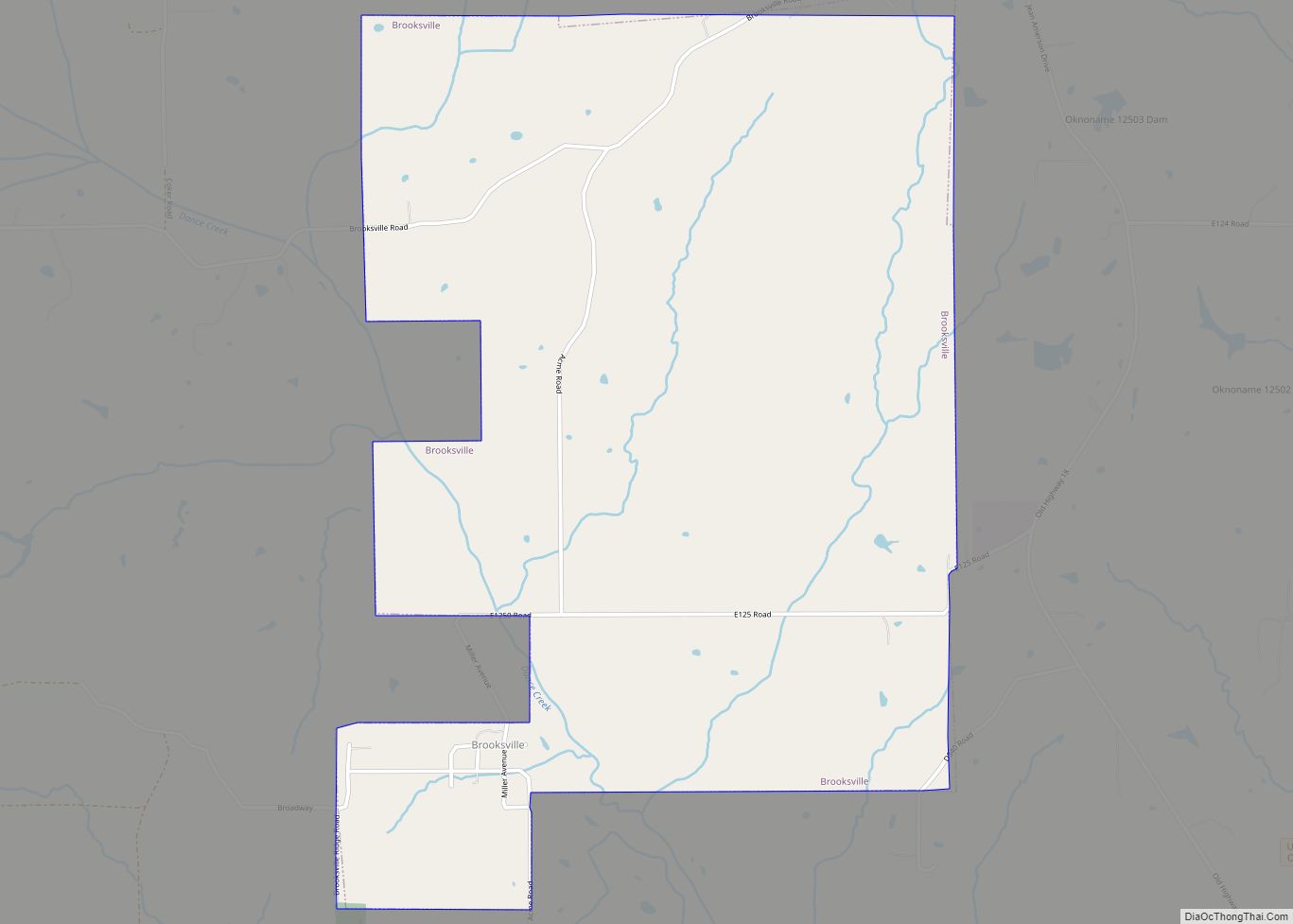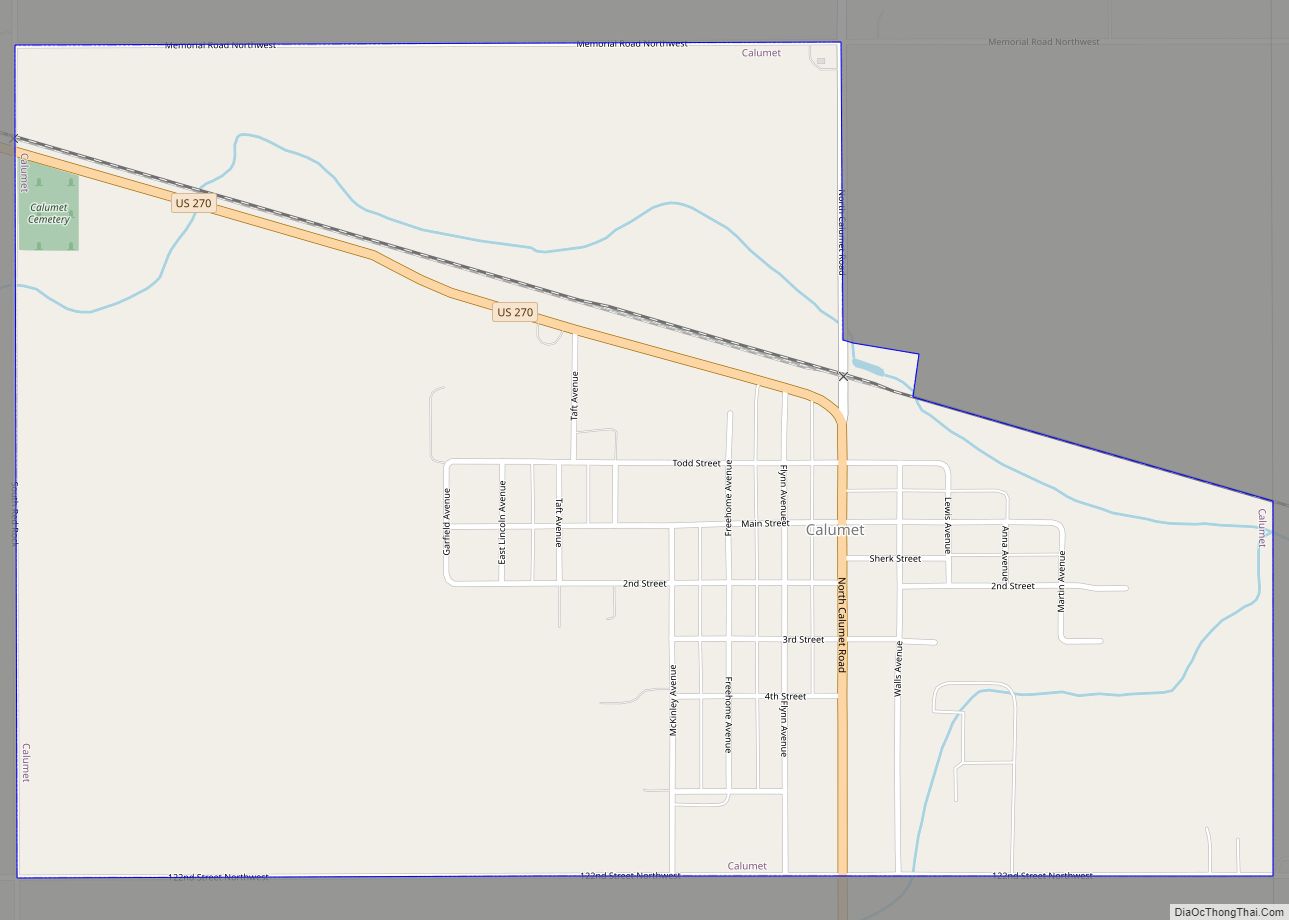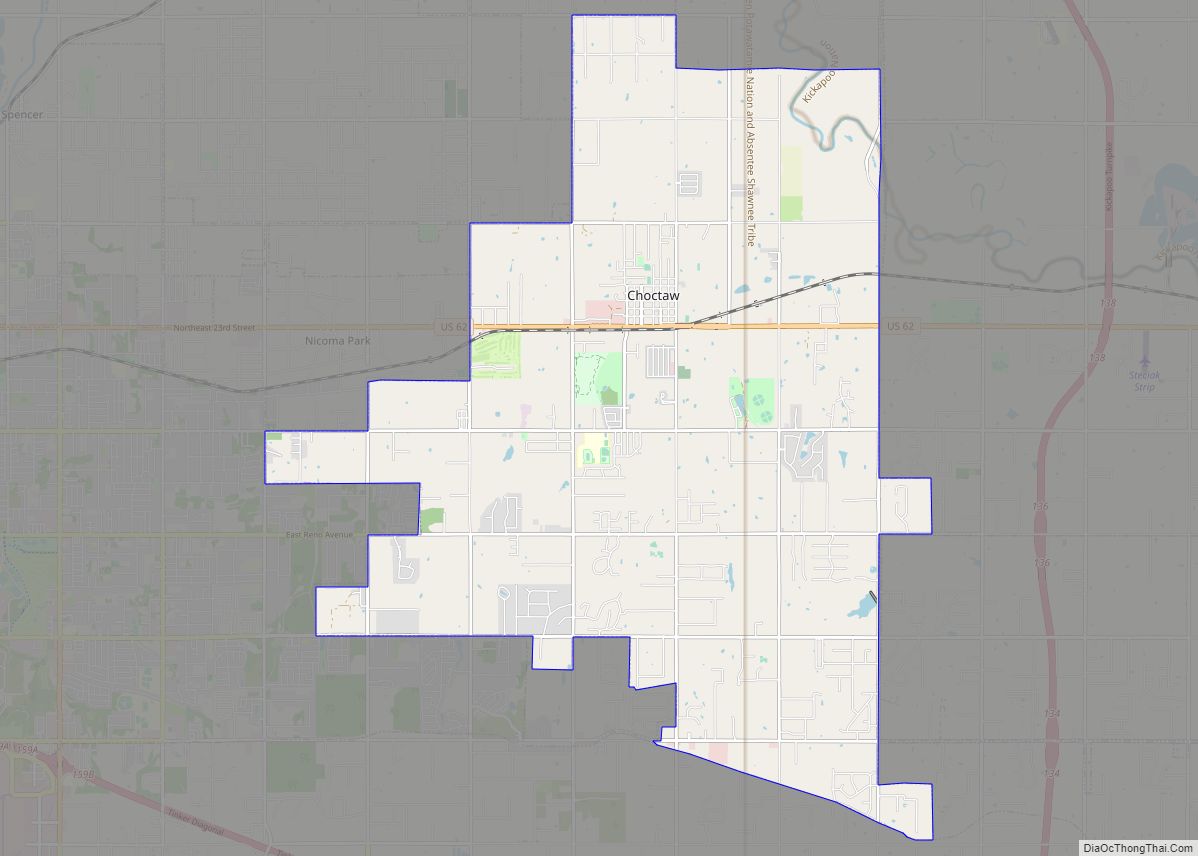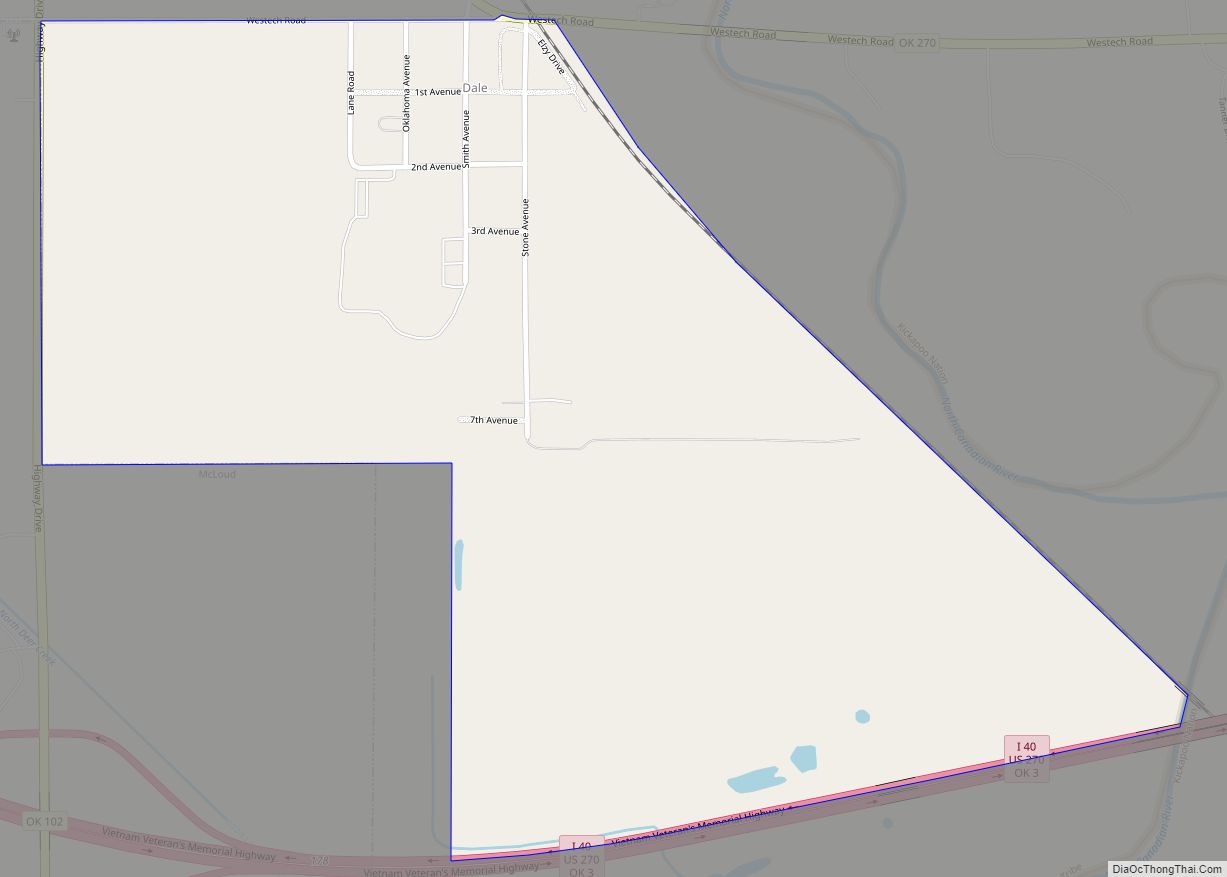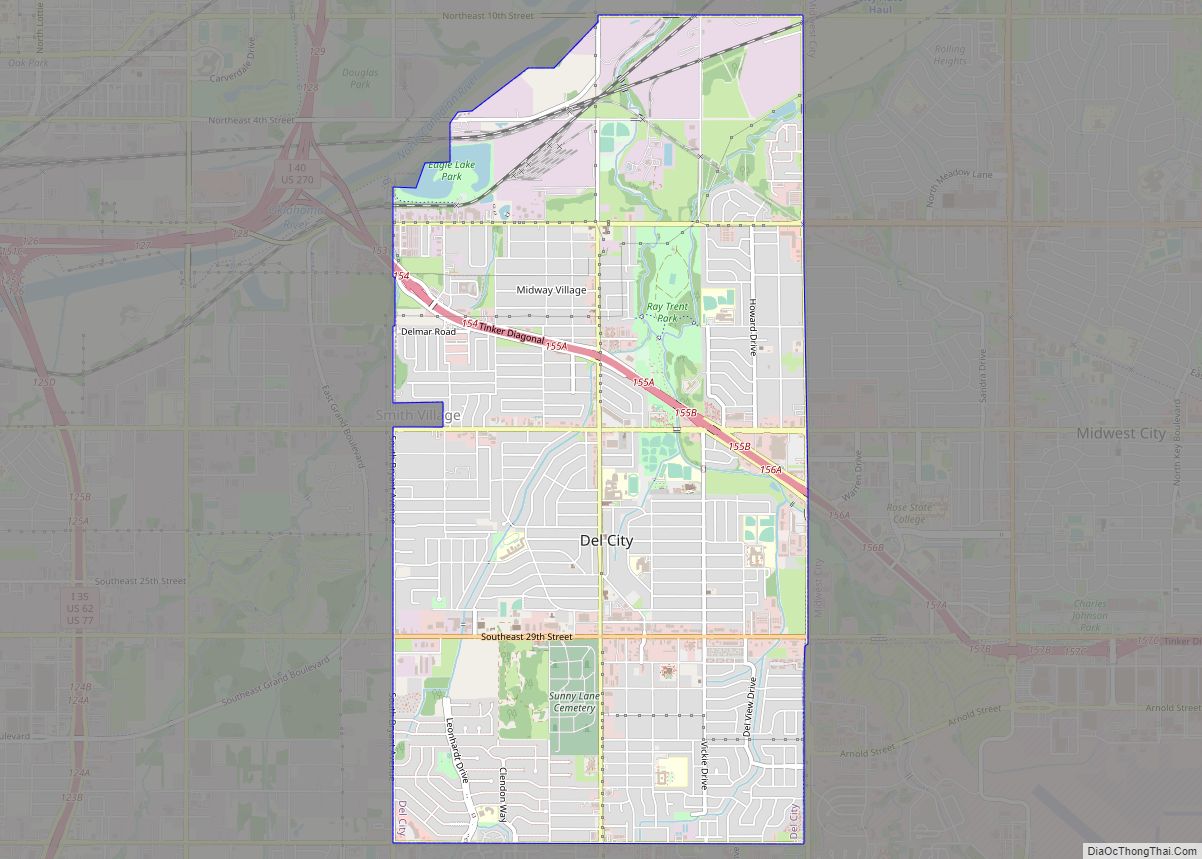Oklahoma City (/oʊkləˌhoʊmə -/ (listen)), officially the City of Oklahoma City, and often shortened to OKC, is the capital and largest city of the U.S. state of Oklahoma. The county seat of Oklahoma County, it ranks 20th among United States cities in population, and is the 8th largest city in the Southern United States. The population grew following the 2010 census and reached 681,054 in the 2020 census. The Oklahoma City metropolitan area had a population of 1,396,445, and the Oklahoma City–Shawnee Combined Statistical Area had a population of 1,469,124, making it Oklahoma’s largest municipality and metropolitan area by population.
Oklahoma City’s city limits extend somewhat into Canadian, Cleveland, and Pottawatomie counties, though much of those areas outside the core Oklahoma County area are suburban tracts or protected rural zones (watershed). The city is the eighth-largest in the United States by area including consolidated city-counties; it is the second-largest, after Houston, not including consolidated cities. The city is also the second largest by area among state capital cities in the United States, after Juneau, Alaska.
Oklahoma City has one of the world’s largest livestock markets. Oil, natural gas, petroleum products, and related industries are its economy’s largest sector. The city is in the middle of an active oil field and oil derricks dot the capitol grounds. The federal government employs a large number of workers at Tinker Air Force Base and the United States Department of Transportation’s Mike Monroney Aeronautical Center (which house offices of the Federal Aviation Administration and the Transportation Department’s Enterprise Service Center, respectively).
Oklahoma City is on the I-35 and I-40 corridors, one of the primary travel corridors south into neighboring Texas and Mexico, north towards Wichita and Kansas City, west to Albuquerque, and east towards Little Rock and Memphis. Located in the state’s Frontier Country region, the city’s northeast section lies in an ecological region known as the Cross Timbers. The city was founded during the Land Run of 1889 and grew to a population of over 10,000 within hours of its founding. It was the site of the April 19, 1995, bombing of the Alfred P. Murrah Federal Building, in which 168 people died, the deadliest terror attack in U.S. history until the attacks of September 11, 2001, and the deadliest act of domestic terrorism in U.S. history.
Since weather records have been kept beginning in 1890, Oklahoma City has been struck by 14 violent tornadoes, 11 of which were rated F4 or EF4 on the Fujita and Enhanced Fujita scales, and one each rated F5 and EF5.
| Name: | Oklahoma City city |
|---|---|
| LSAD Code: | 25 |
| LSAD Description: | city (suffix) |
| State: | Oklahoma |
| County: | Canadian County, Cleveland County, Oklahoma County, Pottawatomie County |
| Founded: | April 22, 1889 |
| Incorporated: | July 15, 1890 |
| Elevation: | 1,198 ft (365 m) |
| Land Area: | 606.48 sq mi (1,570.77 km²) |
| Water Area: | 14.31 sq mi (37.06 km²) |
| Population Density: | 1,122.96/sq mi (433.58/km²) |
| Area code: | 405/572 |
| FIPS code: | 4055000 |
| GNISfeature ID: | 1102140 |
Discover the state of Oklahoma with this collection of maps. Explore the highways, roads, places of interest, and things to do in the state of Oklahoma. Then, take a look at our interactive map of Oklahoma City to explore the city in more detail.
Oklahoma City, the state’s capital, is located in the central part of the state and has a population of around 645,000 people. It is home to a diverse population and is surrounded by several smaller cities and towns. Here, we’ll take you on a whirlwind tour of everything you need to know about Oklahoma City – from its history to its quirky attractions to its must-see things to do.
Online Interactive Map
Click on ![]() to view map in "full screen" mode.
to view map in "full screen" mode.
Oklahoma City is full of great things to see, from art museums to outdoor adventures. Our map will show you how to get around the city and help you find the best places to explore. Whether you are looking for hotels, attractions, or restaurants, you can find all the information you need with a quick tap. Explore Oklahoma City with this map and discover the best areas to live, work, and play. While you’re at it, make sure you’re not missing any of the top attractions or dining spots in Oklahoma City.
Oklahoma City location map. Where is Oklahoma City city?
History
Oklahoma City was settled on April 22, 1889, when the area known as the “Unassigned Lands” was opened for settlement in an event known as “The Land Run”. On April 26 of that year its first mayor was elected, William Couch. Some 10,000 homesteaders settled the area that would become the capital of Oklahoma. The town grew quickly; the population doubled between 1890 and 1900. Early leaders of the development of the city included Anton Classen, John Shartel, Henry Overholser, Oscar Ameringer and James W. Maney.
By the time Oklahoma was admitted to the Union in 1907, Oklahoma City had surpassed Guthrie, the territorial capital, as the new state’s population center and commercial hub. Soon after, the capital was moved from Guthrie to Oklahoma City. Oklahoma City was a major stop on Route 66 during the early part of the 20th century; it was prominently mentioned in Bobby Troup’s 1946 jazz song “(Get Your Kicks on) Route 66” made famous by artist Nat King Cole.
Before World War II, Oklahoma City developed major stockyards, attracting jobs and revenue formerly in Chicago and Omaha, Nebraska. With the 1928 discovery of oil within the city limits (including under the State Capitol), Oklahoma City became a major center of oil production. Post-war growth accompanied the construction of the Interstate Highway System, which made Oklahoma City a major interchange as the convergence of I-35, I-40, and I-44. It was also aided by the federal development of Tinker Air Force Base.
In 1950, the Census Bureau reported the city’s population as 8.6% black and 90.7% white.
Patience Latting was elected Mayor of Oklahoma City in 1971, becoming the city’s first female mayor. Latting was also the first woman to serve as mayor of a U.S. city with over 350,000 residents.
Like many other American cities, the center city population declined in the 1970s and 1980s as families followed newly constructed highways to move to newer housing in nearby suburbs. Urban renewal projects in the 1970s, including the Pei Plan, removed older structures but failed to spark much new development, leaving the city dotted with vacant lots used for parking. A notable exception was the city’s construction of the Myriad Gardens and Crystal Bridge, a botanical garden and modernistic conservatory in the heart of downtown. Architecturally significant historic buildings lost to clearances were the Criterion Theater, the Baum Building, the Hales Building, and the Biltmore Hotel.
In 1993, the city passed a massive redevelopment package known as the Metropolitan Area Projects (MAPS), intended to rebuild the city’s core with civic projects to establish more activities and life to downtown. The city added a new baseball park; a central library; renovations to the civic center, convention center, and fairgrounds; and a water canal in the Bricktown entertainment district. Water taxis transport passengers within the district, adding color and activity along the canal. MAPS has become one of the most successful public-private partnerships undertaken in the U.S., exceeding $3 billion in private investment as of 2010. As a result of MAPS, the population living in downtown housing has exponentially increased, together with the demand for additional residential and retail amenities, such as grocery, services, and shops.
Since the MAPS projects’ completion, the downtown area has seen continued development. Several downtown buildings are undergoing renovation/restoration. Notable among these was the restoration of the Skirvin Hotel in 2007. The famed First National Center is being renovated.
Residents of Oklahoma City suffered substantial losses on April 19, 1995, when Timothy McVeigh detonated a bomb in front of the Murrah building. The building was destroyed (the remnants of which had to be imploded in a controlled demolition later that year), more than 100 nearby buildings suffered severe damage, and 168 people were killed. The site has been commemorated as the Oklahoma City National Memorial and Museum. Since its opening in 2000, over three million people have visited. Every year on April 19, survivors, families, and friends return to the memorial to read the names of each person lost. McVeigh was executed by lethal injection on June 11, 2001.
The “Core-to-Shore” project was created to relocate I-40 one mile (1.6 km) south and replace it with a boulevard to create a landscaped entrance to the city. This also allows the central portion of the city to expand south and connect with the shore of the Oklahoma River. Several elements of “Core to Shore” were included in the MAPS 3 proposal approved by voters in late 2009.
Oklahoma City Road Map
Oklahoma City is a vibrant city with a dynamic downtown and a growing skyline. This map will help you navigate the city and find your way to the attractions you want to see. It also displays color-coded interstate highways, US highways, expressways/parkways, and major roads. Get a bird’s eye view of Oklahoma City with this map and explore the city like a local. Interstates include I-35, I-40, I-44, I-235, and I-240. US highways include 3, 4, 37, 62, 66, 74, 77, 152, and the John Kilpatrick Turnpike. Expressways/parkways include the 39th Expressway, Lake Hefner Parkway, and Memorial Parkway. Major roads include 4th Street, 5th Street, 6th Street, 15th Street, 23rd Street, 29th Street, 36th Street, 39th Street, 44th Street, 74th Street, 134th Street, 149th Street, Broadway Avenue, California Avenue, Cemetery Road, Classen Boulevard, Clear Springs Road, Council Road, Danforth Road, Expressway Street, Grand Boulevard, Harrison Avenue, Hefner Road, K Gaylord Boulevard, Meridian Avenue, Morgan Road, Mustang Road, Newcastle Road, Piedmont Road, Portland Avenue, Reno Avenue, Santa Fe Avenue, Sheridan Avenue, Shields Boulevard, Sooner Road, and Western Avenue.
Discover Oklahoma City with this helpful map. Whether you’re a local or a visitor, this map is the perfect tool for exploring the city. With detailed information on lakes, parks, and populated areas, it’s a valuable resource for anyone planning their own personal itinerary.
Airports: Will Rogers World Airport (OKC)
Cities: Bethany, Blanchard, Choctaw, Del City, Edmond, El Reno, Harrah, McLoud, Midwest City, Moore, Mustang, Newcastle, Nichols Hills, Nicoma Park, Norman, Oklahoma City, Piedmont, Shawnee, Spencer, The Village, Tuttle, Warr Acres, Yukon
Towns: Arcadia, Bethel Acres, Bridge Creek, Forest Park, Jones, Lake Aluma, Luther, Pink, Smith Village, Union City, Valley Brook, Woodlawn Park
10 things to do in Oklahoma City city
Oklahoma City is full of great things to see, from art museums to outdoor adventures. Our map will show you how to get around the city and help you find the best places to explore. Whether you are looking for hotels, attractions, or restaurants, you can find all the information you need with a quick tap. Explore Oklahoma City with this map and discover the best areas to live, work, and play. While you’re at it, make sure you’re not missing any of the top attractions or dining spots in Oklahoma City.
Oklahoma City city Satellite Map
Geography
Oklahoma City lies along one of the primary corridors into Texas and Mexico, and is a three-hour drive from the Dallas-Fort Worth metroplex. The city is in the Frontier Country region in the center of the state, making it an ideal location for state government.
According to the United States Census Bureau, the city has a total area of 620.34 square miles (1,606.7 km), of which 601.11 square miles (1,556.9 km) is land and 19.23 square miles (49.8 km) is water.
Oklahoma City lies in the Sandstone Hills region of Oklahoma, known for hills of 250 to 400 feet (80 to 120 m) and two species of oak: blackjack oak (Quercus marilandica) and post oak (Q. stellata). The northeastern part of the city and its eastern suburbs fall into an ecological region known as the Cross Timbers.
The city is roughly bisected by the North Canadian River (recently renamed the Oklahoma River inside city limits). The North Canadian once had sufficient flow to flood every year, wreaking destruction on surrounding areas, including the central business district and the original Oklahoma City Zoo. In the 1940s, a dam was built on the river to manage the flood control and reduce its level. In the 1990s, as part of the citywide revitalization project known as MAPS, the city built a series of low-water dams, returning water to the portion of the river flowing near downtown. The city has three large lakes: Lake Hefner and Lake Overholser, in the northwestern quarter of the city; and the largest, Lake Stanley Draper, in the city’s sparsely populated far southeast portion.
The population density normally reported for Oklahoma City using the area of its city limits can be misleading. Its urbanized zone covers roughly 244 square miles (630 km) resulting in a 2013 estimated density of 2,500 per square mile (970/km), compared with larger rural watershed areas incorporated by the city, which cover the remaining 377 sq mi (980 km) of the city limits.
Oklahoma City is one of the largest cities in the nation in compliance with the Clean Air Act.
Tallest buildings
Neighborhoods
Oklahoma City neighborhoods are extremely varied, with affluent historic neighborhoods located next to districts that have not wholly recovered from economic and social decline of the 1970s and 1980s.
The city is bisected geographically and culturally by the North Canadian River, which basically divides North Oklahoma City and South Oklahoma City. The north side is characterized by very diverse and fashionable urban neighborhoods near the city center and sprawling suburbs further north. South Oklahoma City is generally more blue collar working class and significantly more industrial, having grown up around the Stockyards and meat packing plants at the turn of the century, and is the center of the city’s rapidly growing Latino community.
Downtown Oklahoma City, which has 7,600 residents, is seeing an influx of new private investment and large scale public works projects, which have helped to resuscitate a central business district left almost deserted by the Oil Bust of the early 1980s. The centerpiece of downtown is the newly renovated Crystal Bridge and Myriad Botanical Gardens, one of the few elements of the Pei Plan to be completed. In 2021 a massive new central park will link the gardens near the CBD and the new convention center to be built just south of it to the North Canadian River, as part of a massive works project known as “Core to Shore”; the new park is part of MAPS3, a collection of civic projects funded by a one-cent temporary (seven-year) sales tax increase.
Climate
Oklahoma City has a temperate humid subtropical climate (Köppen: Cfa), along with significant continental influences. The city features very hot, humid summers, and cool winters with occasional snowfall. Prolonged and severe droughts (sometimes leading to wildfires in the vicinity), as well as very heavy rainfall leading to flash flooding and flooding, occur with some regularity. Consistent winds, usually from the south or south-southeast during the summer, help temper the hotter weather. Consistent northerly winds during the winter can intensify cold periods. Severe ice storms and snowstorms happen sporadically during the winter.
The average temperature is 61.4 °F (16.3 °C), with the monthly daily average ranging from 39.2 °F (4.0 °C) in January to 83.0 °F (28.3 °C) in July. Extremes range from −17 °F (−27 °C) on February 12, 1899 to 113 °F (45 °C) on August 11, 1936, and August 3, 2012; the last sub-zero (Fahrenheit) reading was −14 °F (−26 °C) on February 16, 2021. Temperatures reach 100 °F (38 °C) on 10.4 days of the year, 90 °F (32 °C) on nearly 70 days, and fail to rise above freezing on 8.3 days. The city receives about 35.9 inches (91.2 cm) of precipitation annually, of which 8.6 inches (21.8 cm) is snow.
The report “Regional Climate Trends and Scenarios for the U.S. National Climate Assessment” (NCA) from 2013 by NOAA, projects that parts of the Great Plains region can expect up to 30% (high emissions scenario based on CMIP3 and NARCCAP models) increase in extreme precipitation days by mid-century. This definition is based on days receiving more than one inch of rainfall.
Oklahoma City has an active severe weather season from March through June, especially during April and May. Being in the center of what is colloquially referred to as Tornado Alley, it is prone to especially frequent and severe tornadoes, as well as severe hailstorms and occasional derechoes. Tornadoes have occurred in every month of the year and a secondary smaller peak also occurs during autumn, especially October. The Oklahoma City metropolitan area is one of the most tornado-prone major cities in the world, with about 150 tornadoes striking within the city limits since 1890. Since the time weather records have been kept, Oklahoma City has been struck by 13 violent tornadoes, eleven rated F/EF4 and two rated F/EF5.
On May 3, 1999, parts of Oklahoma City and surrounding communities were impacted by a tornado. It was the last U.S. tornado to be given a rating of F5 on the Fujita scale before the Enhanced Fujita scale replaced it in 2007. While the tornado was in the vicinity of Bridge Creek to the southwest, wind speeds of 318 mph (510 km/h) were estimated by a mobile Doppler radar, the highest wind speeds ever recorded on Earth. A second top-of-the-scale tornado occurred on May 20, 2013; South Oklahoma City, along with Newcastle and Moore, was hit by an EF5 tornado. The tornado was 0.5 to 1.3 miles (0.80 to 2.09 km) wide and killed 23 people. On May 31, less than two weeks after the May 20 event, another outbreak affected the Oklahoma City area. Within Oklahoma City, the system spawned an EF1 and an EF0 tornado, and in El Reno to the west, an EF3 tornado occurred. This lattermost tornado, which was heading in the direction of Oklahoma City before it dissipated, had a width of 2.6 miles (4.2 km), making it the widest tornado ever recorded. Additionally, winds in excess of 295 mph (475 km/h) were measured, one of the two highest wind records for a tornado.
With 19.48 inches (495 mm) of rainfall, May 2015 was by far Oklahoma City’s record-wettest month since record-keeping began in 1890. Across Oklahoma and Texas generally, there was a record flooding in the latter part of the month.
See also
Map of Oklahoma State and its subdivision:- Adair
- Alfalfa
- Atoka
- Beaver
- Beckham
- Blaine
- Bryan
- Caddo
- Canadian
- Carter
- Cherokee
- Choctaw
- Cimarron
- Cleveland
- Coal
- Comanche
- Cotton
- Craig
- Creek
- Custer
- Delaware
- Dewey
- Ellis
- Garfield
- Garvin
- Grady
- Grant
- Greer
- Harmon
- Harper
- Haskell
- Hughes
- Jackson
- Jefferson
- Johnston
- Kay
- Kingfisher
- Kiowa
- Latimer
- Le Flore
- Lincoln
- Logan
- Love
- Major
- Marshall
- Mayes
- McClain
- McCurtain
- McIntosh
- Murray
- Muskogee
- Noble
- Nowata
- Okfuskee
- Oklahoma
- Okmulgee
- Osage
- Ottawa
- Pawnee
- Payne
- Pittsburg
- Pontotoc
- Pottawatomie
- Pushmataha
- Roger Mills
- Rogers
- Seminole
- Sequoyah
- Stephens
- Texas
- Tillman
- Tulsa
- Wagoner
- Washington
- Washita
- Woods
- Woodward
- Alabama
- Alaska
- Arizona
- Arkansas
- California
- Colorado
- Connecticut
- Delaware
- District of Columbia
- Florida
- Georgia
- Hawaii
- Idaho
- Illinois
- Indiana
- Iowa
- Kansas
- Kentucky
- Louisiana
- Maine
- Maryland
- Massachusetts
- Michigan
- Minnesota
- Mississippi
- Missouri
- Montana
- Nebraska
- Nevada
- New Hampshire
- New Jersey
- New Mexico
- New York
- North Carolina
- North Dakota
- Ohio
- Oklahoma
- Oregon
- Pennsylvania
- Rhode Island
- South Carolina
- South Dakota
- Tennessee
- Texas
- Utah
- Vermont
- Virginia
- Washington
- West Virginia
- Wisconsin
- Wyoming
